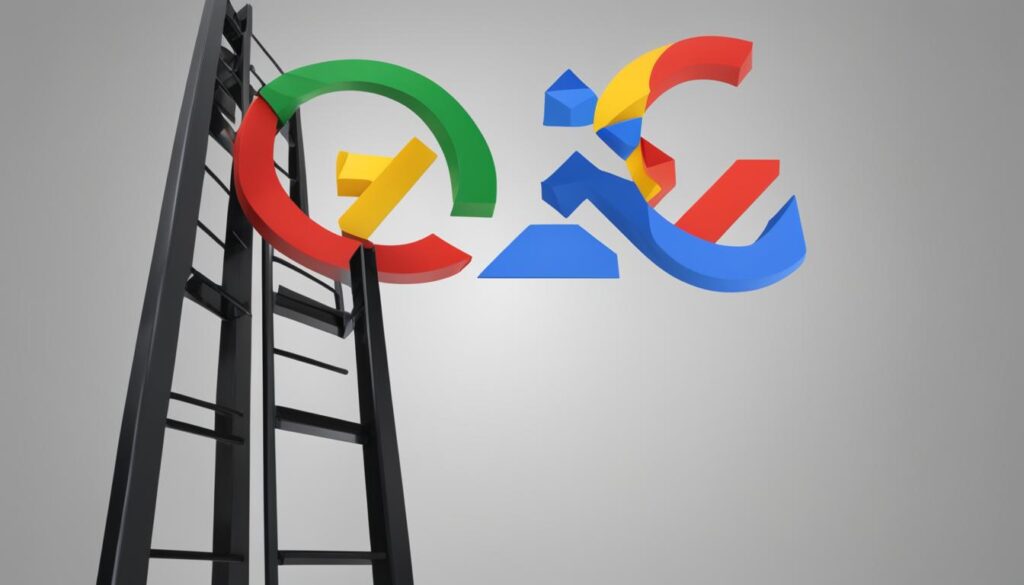Welcome to our comprehensive guide on how to improve your website’s Google rankings. In today’s competitive digital landscape, achieving higher search engine rankings is crucial for maximizing your website’s visibility, increasing organic traffic, and enhancing online visibility. By implementing effective SEO optimization strategies, you can boost your website’s rankings on Google and stay ahead of the competition.
Improving your website’s visibility on Google is not only about appearing on the first page of search results but also about attracting quality organic traffic. With higher search engine rankings, your website will have increased visibility, making it more likely for users to click on your website link and visit your site. This, in turn, can lead to higher conversions, increased brand authority, and greater online success.
In this guide, we will provide you with expert tips and techniques to improve your website’s Google rankings. From on-site SEO optimization to content optimization, technical SEO, and user experience, we will cover all the essential strategies to help you enhance your website’s visibility and achieve higher search engine rankings.
Key Takeaways:
- Improving your Google rankings is crucial for increasing organic traffic and enhancing website visibility.
- Implementing effective SEO optimization strategies can help improve search engine rankings.
- Higher search engine rankings lead to greater online visibility and increased brand authority.
- This guide will provide expert tips and techniques to improve your website’s Google rankings.
- Stay ahead of the competition by optimizing your website’s on-site SEO, content, technical SEO, and user experience.
Understanding Google Ranking
Google rankings play a significant role in determining the visibility of your website in search engine results. To improve your website’s performance and attract more organic traffic, it is crucial to understand the algorithmic process behind these rankings and how they relate to search intent, relevancy, and utility.
Google’s ranking metrics are designed to evaluate the quality and relevancy of web pages in response to a user’s search query. By considering various factors, such as the relevance of content, website authority, and user experience, Google aims to provide the most relevant and useful results to meet the user’s search intent.
When a user performs a search, Google’s algorithm analyzes millions of web pages to determine the most appropriate results. The algorithm takes into account factors like keyword relevance, website authority, page loading speed, and mobile-friendliness to determine the ranking of each domain in the search results.
Understanding how Google rankings work can help you improve your website’s visibility and increase its chances of appearing at the top of search engine results pages. By optimizing your website’s content, structure, and technical aspects, you can enhance its relevancy, increase its utility for users, and ultimately improve its Google ranking.
Google’s ranking metrics strive to provide users with the most relevant and useful results to meet their search intent.
By implementing effective SEO strategies that align with Google’s algorithmic process, you can enhance your website’s visibility, attract more organic traffic, and improve its Google ranking. In the next section, we will provide you with a step-by-step guide to help you achieve these goals.
Step-by-Step Guide to Improve Google Rankings
To improve your website’s Google rankings, follow this comprehensive step-by-step guide. By implementing the right strategies, you can enhance your on-site SEO, optimize your content, and build high-quality backlinks to achieve higher search engine rankings.
1. Optimize your On-Site SEO
Start by focusing on your on-site SEO. This involves optimizing various elements of your website to make it search engine-friendly:
| Elements for On-Site SEO Optimization | Action Steps |
|---|---|
| Title Tags | Ensure your target keyword is included in the title tag and placed towards the beginning. |
| LSI Keywords | Utilize LSI keywords, which are related terms to your target keyword, to improve relevance. |
| Content-Length | Create long-form content with a minimum word count of 1800 words to improve rankings. |
| Keyword Placement | Strategically place your target keyword 2-3 times throughout the content without keyword stuffing. |
2. Content Optimization
Optimizing your content is crucial for better Google rankings. Follow these steps to create high-quality, relevant content:
- Research relevant keywords and target them in your content.
- Understand search intent and align your content accordingly.
- Reduce bounce rate by providing engaging and informative content.

3. Build Quality Backlinks
Backlink building plays a significant role in improving Google rankings. Focus on acquiring high-quality backlinks from authoritative websites:
“Quality backlinks are like endorsements from reputable sources that boost your website’s credibility and authority in the eyes of search engines.” – SEO Expert
Consider these strategies for building backlinks:
- Guest posting on relevant industry websites.
- Participating in industry-specific forums and discussions.
- Creating valuable and shareable content to naturally attract backlinks.
4. Track and Monitor your Results
Tracking and monitoring your website’s performance is crucial to gauge the effectiveness of your SEO strategies. Use analytics tools to monitor key metrics, such as:
- Keyword rankings
- Organic traffic
- Bounce rate
- Conversion rates
Regularly analyze the data and make necessary adjustments to continually improve your Google rankings.
With these step-by-step strategies for improving your Google rankings, you can optimize your website, target relevant keywords, and deliver high-quality content that meets user search intent. Don’t forget to track and monitor your results to adapt and refine your strategies for long-term success.
Improve On-Site SEO
On-page optimization is a crucial aspect of improving Google rankings and boosting your website’s visibility. By implementing effective strategies, you can optimize your on-site SEO and enhance your website’s performance in search engine results.
One key aspect of on-page optimization is title tag optimization. It is essential to place your target keyword towards the beginning of your title tag. This signals its relevance to Google and improves the chances of your website ranking higher for that keyword.
Another important factor is creating long-form content. Long-form content with a minimum word count of at least 1800 words has been shown to improve search engine rankings. By providing comprehensive and detailed information, you increase the value of your content, making it more appealing to both users and search engines.
Keyword optimization is also crucial for on-page SEO. Strategically placing your target keyword 2-3 times throughout the page without keyword stuffing signals its relevance to Google. However, ensure that the placement feels natural and organic within the content.
In addition to optimizing your target keyword, incorporating relevant terms and related keywords, known as LSI keywords, is beneficial. These keywords provide context and further signal the relevancy of your content to search engines. Tools like LSIGraph can help you identify relevant LSI keywords to enhance your content’s optimization.
Optimizing your on-site SEO with these strategies will improve your website’s visibility and increase its chances of ranking higher on Google.

Example Table: Benefits of On-Site SEO
| Benefits | Description |
|---|---|
| Higher Rankings | Optimizing your on-site SEO improves your website’s chances of ranking higher in search engine results pages. |
| Increase Organic Traffic | Improved rankings lead to increased organic traffic as your website becomes more visible to users. |
| Enhanced User Experience | On-site optimization focuses on improving the user experience, leading to higher engagement and reduced bounce rates. |
| Targeted Keyword Placement | Strategically placing keywords on your website helps search engines understand the relevance of your content. |
| Improved Search Visibility | By optimizing your on-site SEO, your website becomes more visible to users searching for relevant keywords. |
Add LSI Keywords and Monitor Technical SEO
Enhancing your content’s relevance is crucial for improving your Google rankings. One effective way to achieve this is by incorporating LSI keywords, which are words and phrases related to your target keyword. By using LSIGraph, a recommended tool, you can easily find relevant LSI keywords that can strengthen the SEO optimization of your content.
However, optimizing your website’s visibility goes beyond content. It also involves closely monitoring your technical SEO to ensure optimal performance. Here are some key areas to focus on:
- Mobile Optimization: With mobile devices accounting for a significant portion of internet traffic, it’s essential to optimize your website for mobile users. Ensure that your site is mobile-friendly, loads quickly on mobile devices, and offers a seamless user experience.
- Site Speed: A slow-loading website can negatively impact user experience and search engine rankings. Regularly monitor and optimize your site speed to provide users with a fast and smooth browsing experience.
- Indexing Issues: Check for any indexing issues that may prevent search engines from properly crawling and indexing your web pages. Resolve any indexing errors and ensure that your website is fully accessible to search engine bots.
By paying attention to both LSI keywords and technical SEO monitoring, you can improve the overall optimization of your website and enhance its visibility on search engine results pages.
Match Content to Search Intent and Reduce Bounce Rate
Matching your content to search intent is crucial for improving Google rankings. When users search for specific keywords or phrases, they have a particular intent in mind. To meet their needs, it’s essential to analyze user behavior, engagement metrics, and bounce rate.
Bounce rate refers to the percentage of users who navigate away from your website after viewing only one page. A high bounce rate indicates that your content may not be relevant or engaging enough for the users’ search query.
To reduce bounce rate and improve engagement, optimize your content’s organization and structure. Ensure that it is easy to navigate, readable, and visually appealing. Use clear headings, subheadings, and bullet points to break up the text and make it scannable.
To grab users’ attention and encourage further exploration of your website, pay special attention to the above the fold section. This is the content that is immediately visible when a user lands on your page without having to scroll down. Make sure it is compelling, informative, and aligned with the users’ search intent.
Content Structure
Here’s an example of an effective content structure:
- Introduction: Provide a brief overview of the topic and what users can expect to find in your content.
- Main body: Organize your content into logical sections, each addressing a specific aspect or subtopic.
- Use headings and subheadings (H3 tags) to guide users and make it easy for them to find the information they’re looking for.
- Include relevant examples, case studies, or statistics to support your points and make your content more credible.
- Conclusion: Summarize the main points and provide a clear call to action or next steps for users.
By structuring your content in a user-friendly manner, you can improve user experience, reduce bounce rate, and increase the likelihood of users engaging with your content and staying on your website.
Analyzing Bounce Rate and Engagement Metrics
| Metrics | Explanation |
|---|---|
| Bounce Rate | The percentage of users who leave a website after viewing only one page. High bounce rates may indicate irrelevant or unengaging content. |
| Time on Page | The average amount of time users spend on a page. Longer average time on page may indicate higher user engagement. |
| Pages per Session | The average number of pages a user views during a single session. Higher pages per session may indicate user interest and engagement with your website. |
Understanding these metrics and regularly monitoring them can provide insights into how your content resonates with users. By optimizing your content based on search intent, reducing bounce rate, and improving engagement, you can enhance your website’s Google rankings and attract more organic traffic.
Conclusion
Improving your Google rankings is essential for increasing website visibility and attracting organic traffic. By implementing effective SEO strategies, you can optimize your website’s visibility and achieve higher search engine rankings.
Following our step-by-step guide, focus on on-site SEO, content optimization, technical SEO, and user experience to enhance your website’s visibility. By continuously tracking and monitoring your results, you can adapt and refine your strategies to further improve your Google rankings.
Remember that a high website visibility and organic traffic are crucial for achieving online success. By implementing SEO strategies and staying updated with the latest trends, you can improve your Google rankings and boost your website’s visibility to a wider audience.





